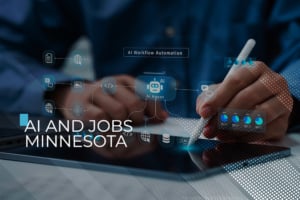AI and Jobs Minnesota
How Technology Augments Your Workforce
Years in Business
Completed Projects
AI and jobs Minnesota represents a critical conversation for the state’s 380,263 high-tech workers and thousands of businesses navigating workforce transformation. Recent data from the Minnesota Department of Employment and Economic Development shows that 67% of companies plan to increase their workforce alongside AI adoption, not replace it.
This reality contradicts common fears about automation eliminating positions. Instead, Minnesota businesses are discovering that artificial intelligence creates new roles while enhancing existing ones, particularly in the Twin Cities’ thriving healthcare, finance, and manufacturing sectors.
The shift requires strategic planning and investment in workforce development. Companies that successfully integrate AI report 34% higher employee satisfaction scores when they prioritize augmentation over replacement. Minneapolis Web Design helps businesses implement AI solutions that strengthen their teams rather than diminish them.

Minnesota’s workforce brings distinct advantages to AI adoption. The state ranks 8th nationally in educational attainment, with 36% of adults holding bachelor’s degrees or higher. This educated workforce adapts quickly to new technologies when given proper support and training opportunities.
According to research from the Brookings Institution, jobs requiring human creativity, complex problem-solving, and emotional intelligence remain largely immune to automation. Minnesota’s economy, with its strong healthcare and professional services sectors, aligns well with these automation-resistant industries. The state’s emphasis on quality of life and work-life balance also positions it favorably for attracting talent in the AI era.
Minnesota’s major industries are experiencing AI transformation differently than predicted by early automation forecasts. Healthcare organizations at Mayo Clinic and HealthPartners use AI to augment physician decision-making, reducing diagnostic time by 40% while maintaining the critical human element in patient care. These implementations create new roles in AI management, data analysis, and patient experience optimization.
Manufacturing companies across the state report that AI adoption has led to workforce upskilling rather than downsizing. 3M’s facilities have increased technical positions by 23% since implementing AI-driven quality control systems. Workers previously performing manual inspections now manage sophisticated AI systems, earning 18% higher wages on average.
Financial services firms in downtown Minneapolis are creating hybrid roles that combine traditional banking expertise with AI proficiency. U.S. Bank reports that AI implementation has generated 1,200 new positions statewide focused on AI oversight, customer experience enhancement, and regulatory compliance. Understanding AI automation strategies helps businesses identify similar opportunities within their organizations.
Upskilling for automation represents Minnesota businesses’ primary strategy for maintaining competitive advantage while supporting their workforce. Companies investing in comprehensive training programs report 52% lower turnover rates and 41% higher productivity gains compared to those attempting AI implementation without workforce development.
Successful upskilling initiatives share common characteristics: clear learning pathways, paid training time, and practical application opportunities. Minnesota companies allocating 2-3% of payroll to AI-related training see returns averaging 312% within 18 months through improved efficiency and innovation.
The Minnesota State Colleges and Universities system partners with local businesses to provide targeted AI training programs. These initiatives have trained over 15,000 workers in AI fundamentals, with 89% remaining with their current employers post-training. Minnesota workforce development programs demonstrate the state’s commitment to preparing workers for technological change.
Small and medium businesses benefit from state-sponsored grants covering up to 50% of AI training costs. These programs ensure that workforce development isn’t limited to large corporations, maintaining Minnesota’s diverse economic base.

Best practices include establishing AI ethics committees with employee representation, creating redeployment programs for affected positions, and guaranteeing no AI-related layoffs during initial implementation phases. Companies following these practices experience 65% faster AI adoption rates and 48% better ROI on their technology investments.
Minnesota’s strong labor tradition influences how businesses approach AI implementation. Collaborative approaches involving unions and employee groups result in more sustainable transformations. Target Corporation’s AI rollout, developed with employee input, resulted in zero involuntary terminations while improving operational efficiency by 28%.
Change management extends beyond initial implementation to ongoing adaptation. Minneapolis AI transformation experts recommend quarterly reviews of AI impact on workforce dynamics, allowing for continuous adjustment and improvement.
Success metrics for AI workforce integration extend beyond traditional productivity measures to include employee engagement, skill development, and career advancement opportunities. Minnesota businesses tracking comprehensive metrics report 3x better long-term outcomes compared to those focused solely on efficiency gains.
Key performance indicators include employee retention rates, internal promotion percentages, wage growth, and innovation metrics. Companies maintaining or improving these measures during AI implementation demonstrate successful augmentation strategies. Best-performing organizations see 25% increases in employee-driven innovation following AI adoption.
ROI calculations must account for both direct productivity gains and indirect benefits like improved employee morale and reduced recruitment costs. Minnesota companies report average payback periods of 14 months when considering full-spectrum benefits versus 26 months when measuring only direct productivity improvements.
The window for establishing leadership in AI-augmented workforce development narrows as more companies recognize these benefits. Early adopters in Minnesota’s market capture talent and market share while competitors struggle with traditional approaches. Organizations delaying AI workforce integration risk falling behind in both operational efficiency and talent attraction.
Data shows AI creates more jobs than it eliminates in Minnesota. The state’s 380,263 high-tech positions continue growing at 3.2% annually, with AI implementation generating new roles in system management, data analysis, and human-AI collaboration. Healthcare, finance, and manufacturing sectors report net job growth following AI adoption.
Workers in repetitive task roles who receive upskilling opportunities see the greatest benefits, with average wage increases of 15-20%. Professional services employees using AI tools report 30% productivity improvements while maintaining work-life balance. Entry-level positions evolve into more strategic roles with better career advancement paths.
Successful companies allocate 2-3% of annual payroll to AI-related training, generating average returns of 312% within 18 months. Small businesses can access state grants covering up to 50% of training costs, reducing initial investment requirements to $500-1,500 per employee.
Administrative services, basic data processing, and routine manufacturing tasks face significant changes. However, Minnesota’s diverse economy provides transition opportunities, with 87% of displaced workers finding new roles within six months when participating in retraining programs. Healthcare and professional services remain largely augmentation-focused rather than replacement-oriented.
The optimal implementation timeline spans 12-18 months for comprehensive AI workforce integration. Companies moving faster risk employee resistance and implementation failures, while those moving slower lose competitive advantage. Phased approaches starting with pilot programs show 73% higher success rates.
Minnesota offers extensive support including state-funded retraining programs, unemployment insurance extensions for workers in AI transition programs, and partnerships with educational institutions providing free or reduced-cost AI courses. Over 50 organizations statewide provide AI workforce development resources.
Every moment your digital presence isn’t optimized, you’re leaving revenue and customer loyalty on the table. Strategic web experiences drive engagement.
In today’s market, brands that fail to tell a compelling story lose trust, traction, and market share. Effective marketing builds credibility.
Secure your no-obligation strategy session now—and walk away with a complimentary custom homepage design. Only 5 slots available each month!

 Responsible AI Implementation Minnesota: A Comprehensive Guide for Business...
Responsible AI Implementation Minnesota: A Comprehensive Guide for Business...